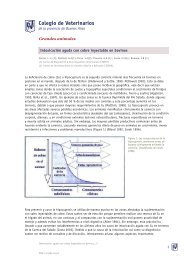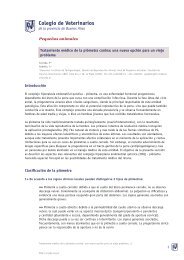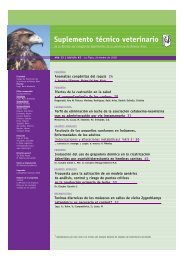Suplemento Ténico Veterinario - Colegio de Veterinarios de la ...
Suplemento Ténico Veterinario - Colegio de Veterinarios de la ...
Suplemento Ténico Veterinario - Colegio de Veterinarios de la ...
You also want an ePaper? Increase the reach of your titles
YUMPU automatically turns print PDFs into web optimized ePapers that Google loves.
pensteijn y col. 2002; Sloane y col., 1999).<br />
La cirugía es el método <strong>de</strong> elección y más ampliamente<br />
usado para <strong>la</strong>s neop<strong>la</strong>sias mamarias caninas,<br />
salvo en presencia <strong>de</strong> enfermedad metastásica, carcinoma<br />
inf<strong>la</strong>matorio o mal estado general <strong>de</strong>l animal.<br />
Las técnicas incluyen nodulectomía, mastectomía,<br />
mastectomía en bloque, mastectomía radical uni o<br />
bi<strong>la</strong>terales (Bojrab y col., 1993; Wilkinson, 1971;<br />
Withrow, 1975).<br />
Las drogas quimioterápicas pue<strong>de</strong>n ser indicadas<br />
para tratar metástasis establecidas, tumores primarios<br />
infiltrados o como adyuvante o neo-adyuvante a<br />
<strong>la</strong> cirugía. Existen diversos protocolos quimioterápicos<br />
disponibles a evaluar para cada caso<br />
en particu<strong>la</strong>r. Las drogas más utilizadas son doxorrubicina<br />
(Hahn, 2001; Hahn y col, 1992; Simon y<br />
col., 2006); ciclofosfamida junto con 5-fluorouracilo<br />
(Karayannopoulou y col., 2001) y mitoxantrona (Ogilvie<br />
y col., 1991).<br />
La utilización <strong>de</strong> antiestrógenos como el tamoxifeno,<br />
como adyuvantes está altamente restringida en <strong>la</strong> especie,<br />
<strong>de</strong>bido a sus severos efectos agonistas (Morris<br />
y col., 1993; Kitchell, 1995). Los agonistas <strong>de</strong> GnRH,<br />
usados a dosis sostenidas en el tiempo inhiben reversiblemente<br />
el eje gonadal, luego <strong>de</strong> un período <strong>de</strong><br />
estimu<strong>la</strong>ción inicial (McRae y col., 1985) que a veces<br />
pue<strong>de</strong> resultar perjudicial.<br />
La radioterapia también pue<strong>de</strong> emplearse como terapia<br />
adyuvante posquirúrgica o en el tratamiento<br />
<strong>de</strong> tumores inoperables o en metástasis óseas (Mc<br />
Leod y Thrall Da 1999), no obstante no existen muchos<br />
reportes referidos a su eficacia en el tratamiento<br />
<strong>de</strong> tumores mamarios. La inmunoterapia es <strong>de</strong> eficacia<br />
controversial (Mc Ewen y col., 1985; Mc Ewen<br />
y Withrow, 1996), aunque se han <strong>de</strong>scriptos algunos<br />
resultados alentadores cuando <strong>la</strong> masa tumoral se reduce<br />
previamente (Harvey y Gilbertson, 1977). Una<br />
teoría publicada en 1989 (Shofer y col., 1989) y citada<br />
en varios textos (Alenza y col., 1998) sugiere que<br />
el consumo <strong>de</strong> una dieta hiperproteica e hipograsa<br />
en perras con cáncer mamario pue<strong>de</strong> prolongar su<br />
tiempo <strong>de</strong> sobrevida.<br />
Actualmente <strong>la</strong>s estrategias terapéuticas <strong>de</strong> <strong>la</strong>s neop<strong>la</strong>sias<br />
mamarias están orientadas a buscar tratamientos<br />
no tóxicos dirigidos a b<strong>la</strong>ncos molecu<strong>la</strong>res<br />
específicos que permitan al animal convivir con <strong>la</strong><br />
enfermedad por un tiempo prolongado. Estas nuevas<br />
terapias, en conjunción con los métodos convencionales<br />
constituyen <strong>la</strong>s prácticas más prometedoras<br />
para los próximos años.<br />
Agra<strong>de</strong>cimientos<br />
G. Hermo es becario <strong>de</strong> CONICET, resolución D N°<br />
0027/08.<br />
BIBIOGRAFIA<br />
1. Ahern, T.E.; Bird, R.C.; Bird, A.E; Wolfe L.G. (1996) Expression<br />
of the oncogene c-erbB-2 in canine mammary cancers<br />
and tumor-<strong>de</strong>rived cell lines. Am J Vet Res 57:693-696.<br />
2. Alenza, D.P.; Rutterman, G.R.; Pena, L.; Beynen, A.C.;<br />
Cuesta, P. (1998) Re<strong>la</strong>tion between habitual diet and canine<br />
mammary tumors in a case-control study. J Vet Int Med<br />
12:132-139.<br />
3. Allen, S.W.; Prasse, K.W.; Mahaffey, E.A. (1986) Cytologic<br />
differentiation of benign from malign canine mammary tumor.<br />
Vet Pathol 23:649-655.<br />
4. Bal<strong>la</strong>re, C.; Uhrig, M.; Bechtold, T.; Sancho, E.; Di Domenico,<br />
M.; Migliaccio, A.; Auricchio, F.; Beato, M. (2003)<br />
Two domains of the progesterone receptor interact with the<br />
estrogen receptor and are required for progesterone activation<br />
of the c-Src/Erk pathway in mammalian cells. Mol Cell<br />
Biol 23:1994–2008.<br />
5. Battistacci, M.; Ca<strong>la</strong>ndra, M.L. (1974) Quantitative measurement<br />
of metabolites of the tryptophane-niacin pathway<br />
in healthy bitches and those affected with mammary dysp<strong>la</strong>sia<br />
and neop<strong>la</strong>sia. Nuova Vet 50:246-252.<br />
6. Birrell, S.N.; Butler, L.M.; Harris, J.M.; Buchanan G.;<br />
Tilley, W.D. (2007) Disruption of androgen receptor signaling<br />
by synthetic progestins may increase risk of <strong>de</strong>veloping<br />
breast cancer. FASEB J 21:2285-2293.<br />
7. Blood, C.H.; Zetter, B.R. (1990) Tumor interactions with<br />
the vascu<strong>la</strong>ture: angiogenesis and tumor metastasis. Acta<br />
Bioch Bioph 1032:89-93.<br />
8. Bojrab, M.J.; Birchard, S.J.; Tomlinson, J.L.(Jr.) (1993)<br />
Técnicas actuales en cirugía <strong>de</strong> pequeños animales. 3rd ed.<br />
Intermedica. Buenos Aires, Argentina. 447-452.<br />
9. Briggs, M.H. (1980) Progestogens and mammary tumours<br />
in the Beagle bitch. Res Vet Sci 28:199-202.<br />
10. Bro<strong>de</strong>y, R.S.; Goldschmidt, M.A.; Roszel, J.R. (1983) Canine<br />
mammary g<strong>la</strong>nd neop<strong>la</strong>sms. J Am Anim Hosp Assoc<br />
19:61-90.<br />
11. Chu, L.L.; Rutteman, G.R.; Kong, J.M.; Ghahremani, M.;<br />
Schmeing, M.; Misdorp, W.; van Gar<strong>de</strong>ren, E.; Pelletier, J.<br />
(1998) Genomic organization of the canine p53 gene and<br />
its mutational status in canine mammary neop<strong>la</strong>sia. Breast<br />
Cancer Res Treat 50:11-25.<br />
12. Conneely, O.M.; Mu<strong>la</strong>c-Jericevic, B.; Lydon, J.P. (2003)<br />
Progesterone-<strong>de</strong>pen<strong>de</strong>nt regu<strong>la</strong>tion of female reproductive<br />
activity by two distinct progesterone receptor isoforms. Steroids<br />
68:771–778.<br />
13. DeVita, V.; Hellman, S.; Rosenberger, S. (1997) Cancer:<br />
Principles and practice of Oncology. 5th. ed. Lippincott-<br />
Raven.<br />
14. Dobson, J.M.; Samuel, S.; Milstein, H.; Rogers, K; Wood,<br />
J.L. (2002) Canine neop<strong>la</strong>sia in the UK: estimates of inci<strong>de</strong>nce<br />
rates from a popu<strong>la</strong>tion of insured dogs. J Small<br />
Anim Pract 43(6):240-246.<br />
15. Donnay, I.; Devleeschower, N.; Wouters-Ballman, P.;<br />
Leclero, G.; Verstegen, J. (1996) Re<strong>la</strong>tionship between receptors<br />
for epi<strong>de</strong>rmal growth factor and steroid hormones in<br />
normal, dysp<strong>la</strong>stic and neop<strong>la</strong>stic canine mammary tissues.<br />
Res Vet Sci 60:251-254.<br />
16. Donnay, I.; Rauis, J.; Verstegen, J. (1994) Influence <strong>de</strong>s<br />
antécé<strong>de</strong>nts hormonaux sur l´apparition clinique <strong>de</strong>s tumeurs<br />
mammaires chez <strong>la</strong> chienne. Étu<strong>de</strong> épi<strong>de</strong>miologique.<br />
Ann Med Vet 138:109-117.<br />
17. Egenvall, A.; Bonnett, B.N.; Ohagen, P.; Olson, P.; Hedhammar,<br />
A.; von Euler, H. (2005) Inci<strong>de</strong>nce of and survival<br />
after mammary tumors in a popu<strong>la</strong>tion of over 80,000 insured<br />
female dogs in Swe<strong>de</strong>n from 1995 to 2002. Prev Vet<br />
74 |
















